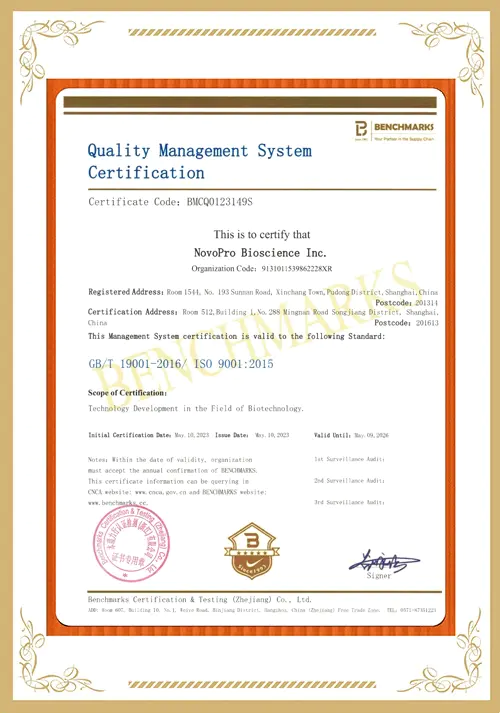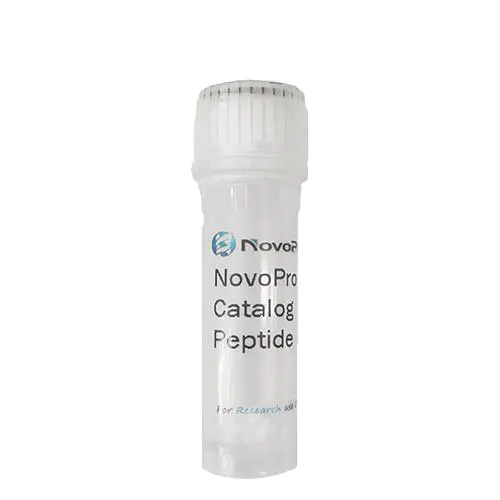AG-73 peptide
Not For Human Use, Lab Use Only.
Cat.#: 319514
Special Price 122.30 USD
-
Product Name
AG-73 peptide
-
Documents
Batch to batch variation of the purity
-
Sequence Shortening
H-RKRLQVQLSIRT-OH
-
Sequence
H-Arg-Lys-Arg-Leu-Gln-Val-Gln-Leu-Ser-Ile-Arg-Thr-OH
-
Length (aa)
12
-
Peptide Purity (HPLC)
96.76%
-
Molecular Formula
C64H120N24O17
-
Molecular Weight
1497.79
-
Source
Synthetic
-
Form
Powder
-
Description
AG-73 causes B16- F10 murine melanoma cells to metastasize to the liver, a site not normally colonized by these cells. In vitro, the AG-73 peptide enhances tumor cell adhesion, migration, invasion, and gelatinase production, and blocks laminin-1-mediated cell migration. AG-73 was found to significantly inhibit cell adhesion to a proteolytic laminin-1 fragment, E3, containing the AG-73 sequence. Cell attachment to AG-73, the E3 fragment, and laminin-1 involved cation-dependent receptors. The minimal active sequence of AG-73, LQVQLSIR, could be one of the most important biologically active sites of laminin-1, especially in promotion of the malignant phenotype. Activation of the malignant phenotype by this peptide provides a significant new model for understanding metastatic mechanisms.
-
Storage Guidelines
Normally, this peptide will be delivered in lyophilized form and should be stored in a freezer at or below -20 °C. For more details, please refer to the manual: Handling and Storage of Synthetic Peptides
-
References
- Kim WH, Nomizu M, Song SY, Tanaka K, Kuratomi Y, Kleinman HK, Yamada Y. Laminin-alpha1-chain sequence Leu-Gln-Val-Gln-Leu-Ser-Ile-Arg (LQVQLSIR) enhances murine melanoma cell metastases. Int J Cancer. 1998 Aug 12;77(4):632-9. doi: 10.1002/(sici)1097-0215(19980812)77:4<632::aid-ijc25>3.0.co;2-6. PMID: 9679769.
-
About TFA salt
Trifluoroacetic acid (TFA) is a common counterion from the purification process using High-Performance Liquid Chromatography (HPLC). The presence of TFA can affect the peptide's net weight, appearance, and solubility.
Impact on Net Weight: The TFA salt contributes to the total mass of the product. In most cases, the peptide content constitutes >80% of the total weight, with TFA accounting for the remainder.
Solubility: TFA salts generally enhance the solubility of peptides in aqueous solutions.
In Biological Assays: For most standard in vitro assays, the residual TFA levels do not cause interference. However, for highly sensitive cellular or biochemical studies, please be aware of its presence.
-
Molar Concentration Calculator
-
Dilution Calculator
-
Percent Concentration Calculator
Mass (g) = Concentration (mol/L) × Volume (L) × Molecular Weight (g/mol)
Related Products / Services
• Peptide Services: NovoPro's peptide synthesis services include standard chemical peptide synthesis, peptide modification, peptide libraries, and recombinant peptide expression.
• Standard Peptide Synthesis: NovoPro offers quality peptides at the most competitive prices in the industry, starting at $3.20 per amino acid. NovoPro provides PepBox – Automatic Quote Tool for online price calculation.
• Peptide Modifications: NovoPro offers a wide range of peptide modification services including isotope labeling (2H, 15N, and 13C), multiple disulfide bonds, multiple phosphorylations, KLH, BSA, ovalbumin, amidation, acetylation, biotin, FITC, etc.
Please note: All products are "FOR RESEARCH USE ONLY AND ARE NOT INTENDED FOR DIAGNOSTIC OR THERAPEUTIC USE"

